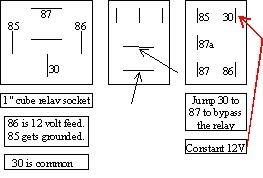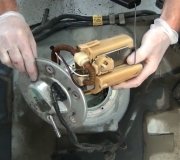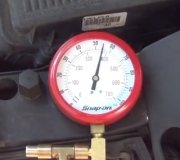Bypassing relays is a common procedure typically done with a piece of wire or a stretched-out paper clip. The problem is all that does is let you take voltage readings in the circuit to locate a break, otherwise the circuit is only turned on when the engine is rotating, (cranking or running).
A lot of people added to this post, but there's little response to say what the solutions were. GM fuel pumps typically fail after they started running, leaving you sitting on the side of the road. Chrysler fuel pumps almost always fail differently. When the internal brushes in the motor are worn, the pump fails to start up. Leaving you sitting in the driveway. It is extremely uncommon for a Chrysler fuel pump to stop running while you're driving.
When you do experience stalling while driving on a Chrysler product, it is usually caused by one of three things. There can be corroded terminals in a connector or some other break in the wire going to the fuel pump. In that case, you'll still have spark when trying to restart the engine.
The second is a failure of the crankshaft position sensor or the camshaft position sensor. It's their two signals that tell the Engine Computer the engine is rotating, and it's time to turn on the automatic shutdown, (ASD) relay. That relay sends 12 volts to the ignition coils, injectors, alternator field, and the fuel pump or pump relay. In this case you will not have spark along with the lack of fuel pressure. Way too many people get hung up on the first thing they find missing, either the loss of spark or the loss of fuel pressure, and waste their time in those systems. This is like saying the right front head light bulb must be burned out because it doesn't turn on, but you failed to notice none of the bulbs turn on because the battery is disconnected. You have to look for all the other symptoms that may be related.
The additional clue to a failed cam or crank sensor is they commonly fail by becoming heat-sensitive on all car brands. It is common for them to work as long as you're driving and natural air flow keeps them cool. When you stop for a short time with a hot engine, as when stopping for gas, engine heat has time to migrate up to the sensors causing one to fail. This will be a crank / no-start with no spark, no injector pulses, and no fuel pump. The clue is the sensor will work again after cooling down for about an hour, then the engine will start like normal. One misleading clue is you'll still have normal fuel pressure. Besides turning on when the engine is rotating, the ASD relay also gets turned on for one second when you turn on the ignition switch. You may hear the hum of the fuel pump for that one second. That is to insure fuel pressure up for starting in case it bled down over days or weeks. With a failed sensor, since the injectors don't pulse open during cranking, none of that fuel pressure is used up. That's why we get confused when we see normal fuel pressure with a crank / no-start problem.
The third cause of stalling is extremely elusive, but it has been around since at least the mid '70s. That is a plugged or collapsing fuel strainer on the fuel pick-up tube inside the gas tank. It is important to note that unlike on other car brands, except for diesel engines, Chrysler fuel filters last the life of the vehicle unless they rust out and start to leak. You will never solve a running problem by replacing the fuel filter, so put that on the bottom of the list of suspects.
The typical symptoms when the strainer becomes blocked, with fuel-injected engines, is the engine runs fine for as many as 15 miles, then the engine stalls when the highest volume of fuel is being pumped, which is during coasting. When this happened to my '88 Grand Caravan, (twice), the engine ran fine for hundreds of miles at highway speed, then stalled when I turned off at my exit ramp. After sitting on the side of the road in a pile of tears for five minutes, it would restart and run okay again for a few miles. The best way to verify this is to connect a fuel pressure gauge and hook it under a wiper arm so you can see what happens to fuel pressure when the stalling occurs. The second time I strapped it to the radio antenna for a year and a half since the problem only occurred when dragging a big tandem axle enclosed trailer that was bigger than the van.
Again, this slowly-dropping fuel pressure while you're driving is commonly caused by the fuel pump on GM vehicles, but Chrysler pumps fail in a different way. This gradual loss of fuel pressure on Chryslers is caused by that strainer in the tank. For most models it is a clipped-on part, but for a few you have to buy a new pump assembly including the housing, not just a pump that gets installed in that housing. It cost $12.00 for my Caravan. Previous to that, I had the same problem with two cars with carburetors. Those strainers cost $3.00 each, but the symptoms were different. With those, the symptoms were identical to simply running out of gas. The slower you drove, the better the engine would run. With fuel injected engines, the faster you drive, the better it runs.
One more note of great value. When you have a crank / no-start on a Chrysler product, and you do have spark, but you don't hear the fuel pump run for one second when turning on the ignition switch, try banging on the bottom of the gas tank. Sometimes it works better if you do that while a helper is cranking the engine, but it usually isn't necessary. Banging will jar the fuel pump's motor just enough for the worn brushes to make contact and get the motor started. From then on it will continue running until you stop the engine. The same problem will occur, perhaps the next time you try to start the engine, or it may be months before it occurs again, but ultimately the fuel pump will need to be replaced.
For anyone trying to bypass a relay, here's the common terminal basing. Connect terminals 30 and 87 together, or those indicated in my nifty drawings.
To everyone who contributed to this question, please post a follow-up telling what your solution was and how you figured it out. That will help others researching the same problem.
Thank you for using 2carpros.
SPONSORED LINKS
Was this helpful?
Yes
No
Sunday, March 1st, 2020 AT 7:01 PM





